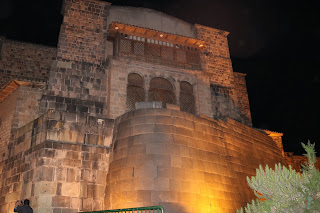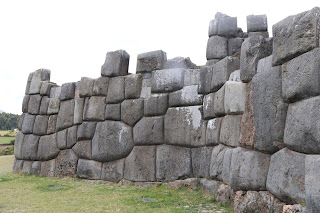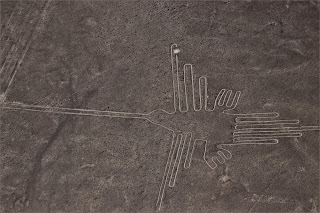In
spite of the crowds we very much enjoyed Cusco where we ended up staying for a
week (including a trip to Machu Picchu).
Many of the streets have a great deal of Inca masonry still extant, some
of the alleyways are narrow and cobbled and have beautiful stonework on both
sides, but generally it’s only up to about head height because the Spaniards in
their usual conservation sensitive manner flattened everything above it and
built their own colonial architecture on top.
The
Plaza de Armas is a great big place which is absolutely rammed with Peruvian
touts all trying to flog massages or tours or lure you into their restaurant or
invite you to stroke their baby alpaca whilst wearing a rather outlandish
version of national costume. When you
manage to fight your way through that lot and the plethora of so-called artisan
shops, there are some wonderful things to be seen. The cathedral, churches and convents are all
great examples of Spanish Colonial flamboyance.
Alleyway, Cusco
Close up showing quality of the Inca stonework
Campesina woman spinning wool in the alleyway
Inca Temple of the Sun with Spanish Cathedral built on top
Temple of the Sun in daylight
Convent de Santa Catalina, Cusco
Pretty display of a load of old bones, Convent de San Francisco
Templo de la Compania de Jesus, Plaza de Armas
We
spent a day driving around the archaeological sites that surround Cusco. The
first one we stopped at was particularly impressive, it was a sort of hilltop
fort, built apparently in the shape of a Puma’s head and the jaggy walls
which zig zagged across one side of it represented the teeth of the Puma.
Sacsayhuaman archaeological site showing representation of Puma's teeth
Inca stonework
Inca doorway
The
stonework was phenomenal. The walls were
made of the most massive stones, some of them apparently weighing over three
hundred tons and these were finely fitted together following the natural shape
of the stone itself, so if the stone was trapezoidal in shape then that was how
it was laid and other stones were fitted to it.
In a lot of places you couldn’t get a blade of a knife between these
mighty rocks.
Some of these stones weigh over 300 tons
Inca baths at Tambo Machay
We
were told that many thousands of people were used to build the sites and many
thousands died in the process. There is
in fact a legend, hopefully only a legend, that three thousand workers, or
possibly slaves, died moving one huge boulder, although whether it fell on them
or they got terminal hernias in the process is not disclosed.
Wild Iris
We
decided that we would visit Machu Picchu but as it is very difficult to access
independently, there being no road, we threw ourselves on the mercy of a tour
operator and signed up for a two day trip.
On day
one we were collected from our hotel and first of all taken on a tour of the
Sacred Valley which included Inca sites at Pisac and Ollantaytambo. This would
probably have been very enjoyable had they not been completely thronged with
tourists. In some places we were trying
to climb up the various edifices and it was a little bit like Kings Cross
Station escalator only the escalator had broken. However, the ruins were impressive, the views
were good, and the countryside was stunning.
Inca agricultural terracing at Pisac ruins
Sue at Pisac ruins
View of the Sacred Valley from Pisac ruins
Inca terracing still in use today
Ollantaytambo Archaeological site
At
Ollantaytambo we boarded a train which chuffed on down along the course of the
mighty River Urubamba until we reached Aguas Calientes, also known as Machu
Picchu Pueblo, an hour and a half later.
Rio Urubamba, no place for a kayaker
We
stopped for the night in Aguas Calientes and then were up early next morning to
go and see the big attraction. After
queuing for about half an hour together with several hundred other eager
visitors we boarded a bus which took us up the switchback road which climbed
the side of Machu Picchu mountain to the ruins.
The winding road to Mach Picchu
Once
there we met our guide, jostled our way through the turnstiles and started
climbing up to the top of the Machu Picchu site in an absolute scrum of people.
It was about then that we had a brief debate and decided that we did not want
to wander around in the Machu Picchu ruins with about 5,000 other people all
taking selfies. We therefore tactfully
told the guide that we didn’t need him, and would he just kindly put us on the
path to the Sun Gate and he could go and do whatever it is that guides do when
they’re not guiding.
Machu Picchu
View from Machu Picchu
The multitudes at Mach Picchu
This
was much, much better. We followed the
stony track up the hill past a halfway house, past a lot of bamboo, wild
begonias and huge orchids, frequently turning to look at the stunning view of
Machu Picchu ruins below us. When we got
to the Sun Gate just over an hour later there was another couple there, so we
got them to take a photograph of us to mark the occasion.
The path to the Sun Gate
Llama feeding by the path
Orchids next to the path, Machu Picchu far below
Sue and Alan at the Sun Gate
At the Sun Gate (Alan needs a haircut)
Coming
back down it started to rain so the track got a little slippery. Our descent was further enlivened by the
sight of a snake which Alan thought was almost certainly venomous. It had a diamond pattern on its back, and we
watched it slither rather reluctantly over the edge of the path and down into
the undergrowth.
Tree Orchids next to the path
Machu Picchu through the clouds
Had it
not been for the walk to the Sun Gate our experience of Machu Picchu would have
been very disappointing. After queuing
yet again for the bus, another train journey (delayed by an hour due to a
landslide), and the final car journey from Ollantaytambo, we finally arrived
back in Cusco at 11.30 pm.
Unsurprisingly, we awarded ourselves a day of R & R before
continuing on our way.
From
Cusco we had a 700 km journey across the Andes to Nazca which is near the
coast. We drove up the mountains, we
drove down the mountains, and we drove around the mountains. Sometimes we were up on the high Altiplano where
herds of alpaca and vicuna were grazing and sometimes we drove through lush
river valleys which narrowed to steep gorges where condors flew overhead. We stopped off at small rural towns and never
saw a single tourist for the whole three days that it took us to reach Nazca!
Lunch stop next to strange 'ice cream cone' rock formations
Just another Andean view
Rocky mountain stream (Can you spot the Torrent Duck? Sue did!)
Nazca
is a lively, bustling town but it is also the place from where you can go to
see the Nazca Lines. The Nazca Lines are
a series of animal figures and geometric shapes, some up to half a kilometre in
length, which are drawn across some 500 sq km of the bleak, stony desert. They remain one of the world’s biggest
archaeological mysteries and there have been many theories about how they were
created and what they represent. One of
the more bizarre theories is that of Erich von Daniken, the populist author,
who claimed that the Lines were built as runways for alien spaceships!
Erich von Daniken's idea of a Spaceman
The Hummingbird (1/2 kilometre long)
Long
before we set out on this trip the Nazca Lines were high on Alan’s list of
‘must see’. Apparently, the best way to
fully appreciate the Lines is from the air, which is exactly what he did. Sue declined the opportunity on the basis
that she didn’t want to be bounced around in a tiny aircraft, although she was
able to see a couple from a viewing tower.
The
Nazca Lines were everything that Alan had been led to believe and he was very
impressed. The Altimeter read 2,500
metres and the little aircraft bobbed and wove its way around, banking from
time to time (somewhat alarmingly), the better to take photographs of the
various objects which were etched in the desert at about the same time as the
birth of Christ.
Nazca Lines, The Whale
The Dog (with spare leg)
The Monkey
The Spider
The Condor
There
are a number of other interesting archaeological sites from the Nazca period
and we particularly enjoyed visiting the Cantalloc Aqueduct. This comprises a series of large conical
spirals, laboriously constructed out of stone, which apparently serve as air
vents for a vast underground canal system that syphons water from rivers higher
in the valley. It was designed and
constructed by the Nazca people and is still in use today for agricultural
irrigation.
Inca Trading Centre at Los Paredones
Sue at El Telar
View of access points to Cantalloc Aquaduct from the air
Spiral access to the aquaduct
Sue going down the plughole
Stonework in the spirals
The
two day drive from Nazca to Lima completed the last lap of this trip. Lima is a large, noisy, capital city with not
a great deal to recommend it other than it is the port from where Footloose
Lucy will be shipped back home and from where we will follow by plane shortly
after. So, now begins the customary
process of stamping one’s feet, banging on people’s tables and tearing one’s
hair out (not that Alan has much of that left) prior to getting Lucy inserted
or, to use the elegant term of the South Americans, ‘stuffed’ inside a
container, sealed and sent off on the high seas.
In the
meantime, we are making the most of our time in Lima, visiting the various
sights in and around the city, and sampling restaurants as we go. The seafood restaurants around fisherman’s
harbour are particularly good!
Inca Tern with its favourite meal of Anchovy
Pair of Belcher's Gulls (note tricolour beaks)
Brown Pelican
In the Fish Market
Brown Pelican
Pair of Inca Terns
Inca Tern
Inca Tern
When
we started this trip, our final one to South America, we had five main
objectives: to visit the Atacama Desert in Northern Chile, the Salar Uyuni salt
flats in Bolivia, Dinosaur footprints in the Toro Toro National Park in Bolivia,
Cusco/Machu Picchu and the Nazca Lines, all in Peru. We achieved all those objectives and were not
disappointed, but we have seen and experienced so much more that has amazed and
delighted us.
In
Northern Argentina we stayed in an area called Quebrada de Humahuaca, a beautiful
valley overlooked by mountainsides that have been eroded into spectacular
formations that reveal waves of colours.
We have stumbled across numerous carnivals and fiestas with brightly
costumed dancers and noisy bands. We made a humbling visit to the Potosi Silver
mine in Bolivia and witnessed the appalling conditions in which the miners work. In the Colca Canyon, we watched great condors
rise up through the depths of the canyon in the early morning, flying so close
to the walls of the canyon that you felt you could almost reach out and touch
them.
At
least two thirds of our time has been spent in the Andes, at anything from
2,500 metres to nearly 5,000 metres.
Everything the Andes has to offer has been spectacular, from the vast snow-capped
mountains, to the bleak Altiplano with grazing herds of vicuna and alpaca, to
the lush green valleys. We and Lucy have
found the altitude quite difficult to cope with at times, but it was worth it!
Our route across South America
Now we
are looking forward to returning home and catching up with family and friends.























































